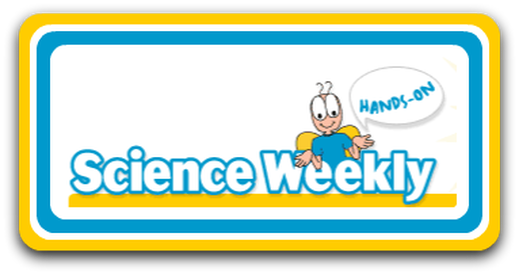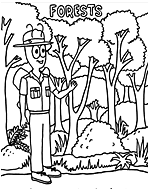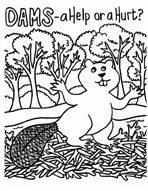Science Weekly Newsletters:
Tools for Homeschoolers?
I love science.
Not to the point that I grew up and became a scientist, or that my #1 passion in life is in the field of science.
But I'm curious - about everything. I love to learn more about life, people, and also science topics. I'm not so worried about the latest craze in designer purses or in which mutual fund I should invest.
When I was teaching in the public schools, the science texts were typically systematic, ordered, and so shallow at the elementary school levels that almost none of the children enjoyed science. There just wasn't enough depth to really dive into topics with gusto! Since we also weren't provided with funds to pay for supplies for experiments, it was challenging to provide those opportunities for my students, too.
Not to the point that I grew up and became a scientist, or that my #1 passion in life is in the field of science.
But I'm curious - about everything. I love to learn more about life, people, and also science topics. I'm not so worried about the latest craze in designer purses or in which mutual fund I should invest.
When I was teaching in the public schools, the science texts were typically systematic, ordered, and so shallow at the elementary school levels that almost none of the children enjoyed science. There just wasn't enough depth to really dive into topics with gusto! Since we also weren't provided with funds to pay for supplies for experiments, it was challenging to provide those opportunities for my students, too.
Recently, I was provided with one issue of Science Weekly, in all of its six levels, for the girls and I to view and see what we thought of it.
At first, I thought that I would be receiving a series of issues on a weekly basis, for a few weeks or so. Actually, what I received was one issue containing one topic in a newsletter format, and I received all six grade levels for that one topic: FRACTIONS.
Each level of the Science Weekly paper newsletter is made from an 11x17" piece of paper which has been printed on both sides and then folded in half. This provides you with four colorful pages of material for your children.
While I realize that mathematics are closely intertwined with the field of science, I was hoping to be able to look at an issue whose topic was specifically geared to something in the field of science. Maybe at some point in the future, I'll be able to view some of their other topical newsletters that cover one topic from more of a scientific perspective.
After the girls and I read through the various levels of Science Weekly, we learned that while this product contains the word "weekly" in its title, there are 15 issues per school year that are sent to subscribers. Most of the activities and experiments contained within one of these newsletters can easily be done within one week's time, and often, much sooner.
Bright!
Colorful!
Those were my girls' first impressions. I asked them to glance through all six levels and choose the newsletter that seemed a bit challenging and yet not too overwhelming.
The six levels of Science Weekly follow this format:
I like the way that Science Weekly has chosen to label its levels. If you are educating your children at home, or are a parent who is supplementing your child's public or private school science experiences, it's nice to know that if you have an advanced learner, you can choose a level that is higher than grade level for your child, and not have to deal with pride about being in an advanced level. In addition, if your child is developmentally delayed or struggles with reading or other issues which make it more difficult to stay on grade level, you may select a lower level for your child without insulting him or her.
Level E, on Fractions, began with a history of fractions starting with the Egyptians. I like the conversational style of writing in these newsletters, and the clear, high quality graphics to support the text. Level E contained some riddles, some mathematical vocabulary and definitions in easy-to-understand text and pictures, a step-by-step writing project for the student to be able to describe how to explain fractions to a new student, and a fun (yet difficult) math Sudoku puzzle.
Level E also contained a lab project that could easily coordinate with an ecological problem about water quality in streams. Several links were provided for children who would want to know more about the ways that fractions are used in everyday life. Fractions' use in music was also described. And a little "Meet the Scientist" feature described an individual whose life revolves around math and what kinds of things he did during his K-12 years to further his math education.
It was easy to see while looking at all six levels in this particular issue that the activities greatly vary from level to level, which is appropriate since this covers grades Pre-K through 6th.
While my girls liked the newsletter format and the bright colors and graphics, I don't think they would rank Science Weekly as one of the highlights of their science studies this year. They seemed okay to work through one of the newsletters, but I could tell that this probably wouldn't be something that they'd beg for if additional issues came in the mail. I can't think of any specific reason why Science Weekly didn't resonate with them as much as I thought it would.
Maybe it's because they are used to diving quite deeply into science subjects in our homeschooling. For example, last year, we spent the entire school year on studying creatures that fly: birds, bats, flying insects. This year, Brittany is doing an in-depth study of the human body, while Kelsi at 7th grade is working on a challenging text in General Science which is far better than anything I ever had to use when I was a student. Our particular science curricula we use in our home is very ordered, with great depth, and maybe my girls felt like there was not enough depth in Science Weekly to read through four pages of science information.
I think that many students, especially those with interests in science areas, would really enjoy the Science Weekly newsletters. They are engaging, include hands-on activities to do at home or in a classroom, provide opportunity for more research and closer examination of the topic being studied, and are clear and easy to read.
If you'd like to take a look at some issues of Science Weekly, you'll find some samples here for the K-4th grade levels.
Each order will receive the levels which are ordered as well as Teaching Notes for the parent or teacher for that particular issue; one brochure of teaching notes includes all of the information for all six levels.
What about the cost for Science Weekly?
The Individual Rate (less than 20 subscriptions to one mailing address) is what most homeschoolers would be receiving if they ordered this product. The Individual Rate contains 15 issues for $19.95 per year...per level that you order.
The Classroom Rate is $4.95 per student per year for 15 issues, as long as the teacher is ordering at least 20 copies.
You can find the Science Weekly order form here on their website.
While I wasn't reviewing Science Weekly's new Interactive Downloads, you can take a look at them and let me know what you think about them!
Here are some of the Science Weekly topics which have been covered during this school year so far:
September - December 2010
January - April 2011
While I enjoyed looking at the various levels of this particular Science Weekly newsletter we received, I kept thinking that I'd rather have a web-based unit study developed for me on one topic, that was accessible online with weblinks, etc., and avoid the shipping costs which I would guess would make up much of the cost of Science Weekly. I'd rather have a 10-page unit study on one topic, which I would view online, or print out at my leisure, than have such a brief newsletter that costs this much because of the regular shipping fees and associated costs with mailing anything these days.
One additional note: Science Weekly's website also contains some printable science coloring books that would work well for the lower elementary ages. These are available for download at no charge. They are seven pages in length and contain six coloring pages as well as one page that contains additional information and an order form.
At first, I thought that I would be receiving a series of issues on a weekly basis, for a few weeks or so. Actually, what I received was one issue containing one topic in a newsletter format, and I received all six grade levels for that one topic: FRACTIONS.
Each level of the Science Weekly paper newsletter is made from an 11x17" piece of paper which has been printed on both sides and then folded in half. This provides you with four colorful pages of material for your children.
While I realize that mathematics are closely intertwined with the field of science, I was hoping to be able to look at an issue whose topic was specifically geared to something in the field of science. Maybe at some point in the future, I'll be able to view some of their other topical newsletters that cover one topic from more of a scientific perspective.
After the girls and I read through the various levels of Science Weekly, we learned that while this product contains the word "weekly" in its title, there are 15 issues per school year that are sent to subscribers. Most of the activities and experiments contained within one of these newsletters can easily be done within one week's time, and often, much sooner.
Bright!
Colorful!
Those were my girls' first impressions. I asked them to glance through all six levels and choose the newsletter that seemed a bit challenging and yet not too overwhelming.
The six levels of Science Weekly follow this format:
- Science Weekly Level Pre-A ~ Kindergarten
- Science Weekly Level A ~ Grade 1
- Science Weekly Level B ~ Grade 2
- Science Weekly Level C ~ Grade 3
- Science Weekly Level D ~ Grade 4
- Science Weekly Level E ~ Grades 5-6
I like the way that Science Weekly has chosen to label its levels. If you are educating your children at home, or are a parent who is supplementing your child's public or private school science experiences, it's nice to know that if you have an advanced learner, you can choose a level that is higher than grade level for your child, and not have to deal with pride about being in an advanced level. In addition, if your child is developmentally delayed or struggles with reading or other issues which make it more difficult to stay on grade level, you may select a lower level for your child without insulting him or her.
Level E, on Fractions, began with a history of fractions starting with the Egyptians. I like the conversational style of writing in these newsletters, and the clear, high quality graphics to support the text. Level E contained some riddles, some mathematical vocabulary and definitions in easy-to-understand text and pictures, a step-by-step writing project for the student to be able to describe how to explain fractions to a new student, and a fun (yet difficult) math Sudoku puzzle.
Level E also contained a lab project that could easily coordinate with an ecological problem about water quality in streams. Several links were provided for children who would want to know more about the ways that fractions are used in everyday life. Fractions' use in music was also described. And a little "Meet the Scientist" feature described an individual whose life revolves around math and what kinds of things he did during his K-12 years to further his math education.
It was easy to see while looking at all six levels in this particular issue that the activities greatly vary from level to level, which is appropriate since this covers grades Pre-K through 6th.
While my girls liked the newsletter format and the bright colors and graphics, I don't think they would rank Science Weekly as one of the highlights of their science studies this year. They seemed okay to work through one of the newsletters, but I could tell that this probably wouldn't be something that they'd beg for if additional issues came in the mail. I can't think of any specific reason why Science Weekly didn't resonate with them as much as I thought it would.
Maybe it's because they are used to diving quite deeply into science subjects in our homeschooling. For example, last year, we spent the entire school year on studying creatures that fly: birds, bats, flying insects. This year, Brittany is doing an in-depth study of the human body, while Kelsi at 7th grade is working on a challenging text in General Science which is far better than anything I ever had to use when I was a student. Our particular science curricula we use in our home is very ordered, with great depth, and maybe my girls felt like there was not enough depth in Science Weekly to read through four pages of science information.
I think that many students, especially those with interests in science areas, would really enjoy the Science Weekly newsletters. They are engaging, include hands-on activities to do at home or in a classroom, provide opportunity for more research and closer examination of the topic being studied, and are clear and easy to read.
If you'd like to take a look at some issues of Science Weekly, you'll find some samples here for the K-4th grade levels.
Each order will receive the levels which are ordered as well as Teaching Notes for the parent or teacher for that particular issue; one brochure of teaching notes includes all of the information for all six levels.
What about the cost for Science Weekly?
The Individual Rate (less than 20 subscriptions to one mailing address) is what most homeschoolers would be receiving if they ordered this product. The Individual Rate contains 15 issues for $19.95 per year...per level that you order.
The Classroom Rate is $4.95 per student per year for 15 issues, as long as the teacher is ordering at least 20 copies.
You can find the Science Weekly order form here on their website.
While I wasn't reviewing Science Weekly's new Interactive Downloads, you can take a look at them and let me know what you think about them!
Here are some of the Science Weekly topics which have been covered during this school year so far:
September - December 2010
- Pulleys
- Cats
- The Flu
- Glass
- Fractions
- Composting
- The Science of Movies
- The Science of Money
January - April 2011
- Scuba Diving
- Poisonous Animals
- Caves
- Teeth
- Deserts
- Green Buildings
- The Moon
While I enjoyed looking at the various levels of this particular Science Weekly newsletter we received, I kept thinking that I'd rather have a web-based unit study developed for me on one topic, that was accessible online with weblinks, etc., and avoid the shipping costs which I would guess would make up much of the cost of Science Weekly. I'd rather have a 10-page unit study on one topic, which I would view online, or print out at my leisure, than have such a brief newsletter that costs this much because of the regular shipping fees and associated costs with mailing anything these days.
One additional note: Science Weekly's website also contains some printable science coloring books that would work well for the lower elementary ages. These are available for download at no charge. They are seven pages in length and contain six coloring pages as well as one page that contains additional information and an order form.





